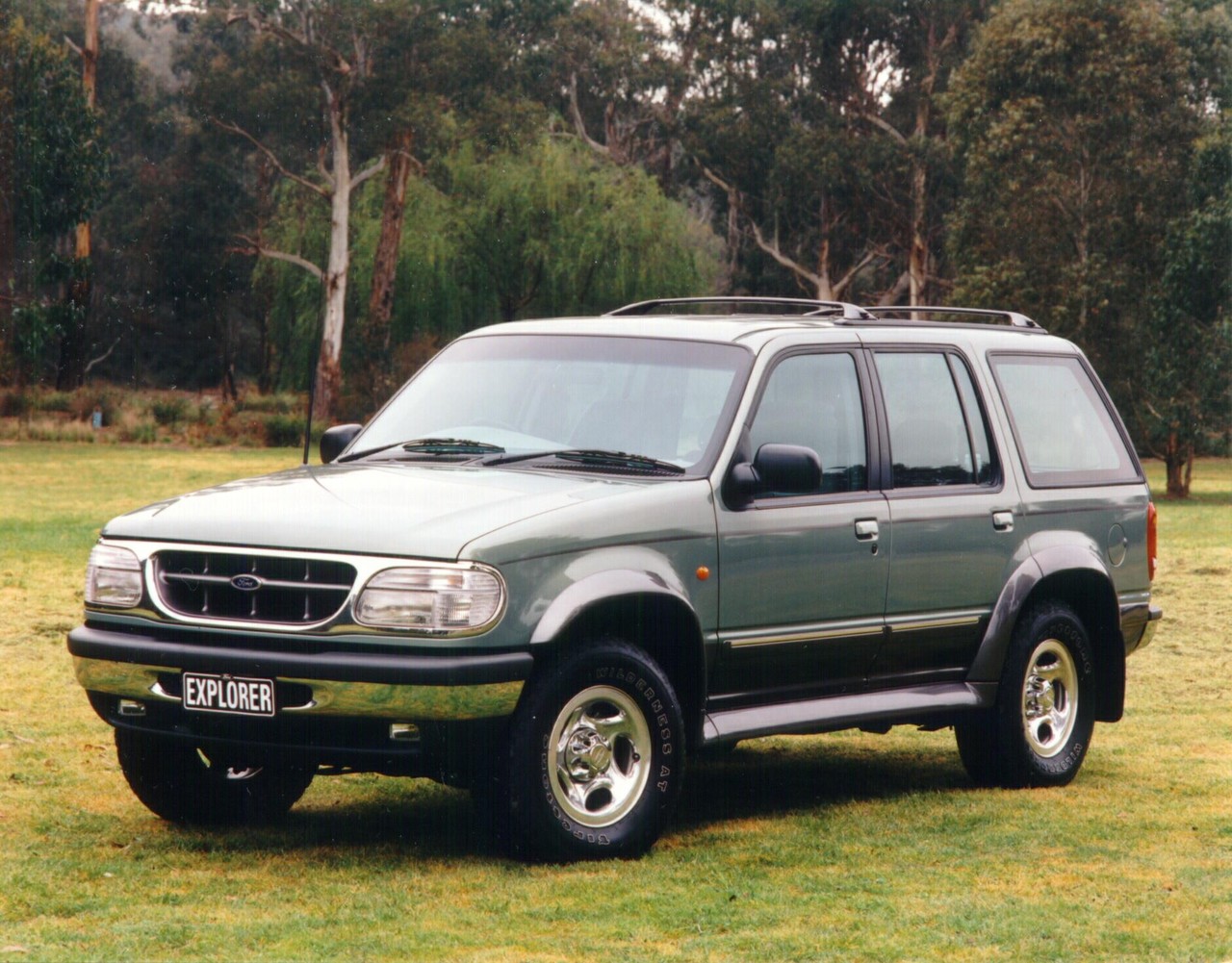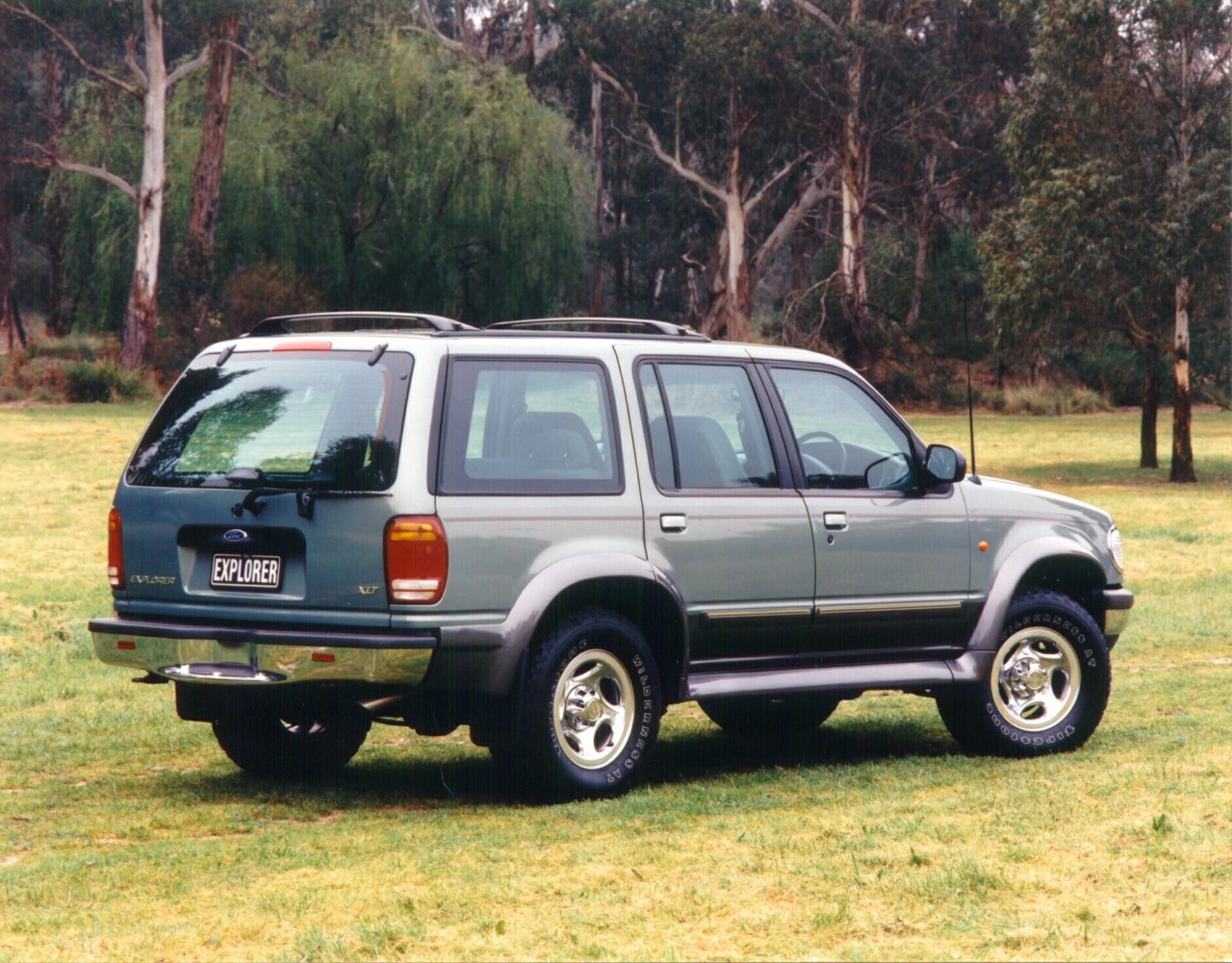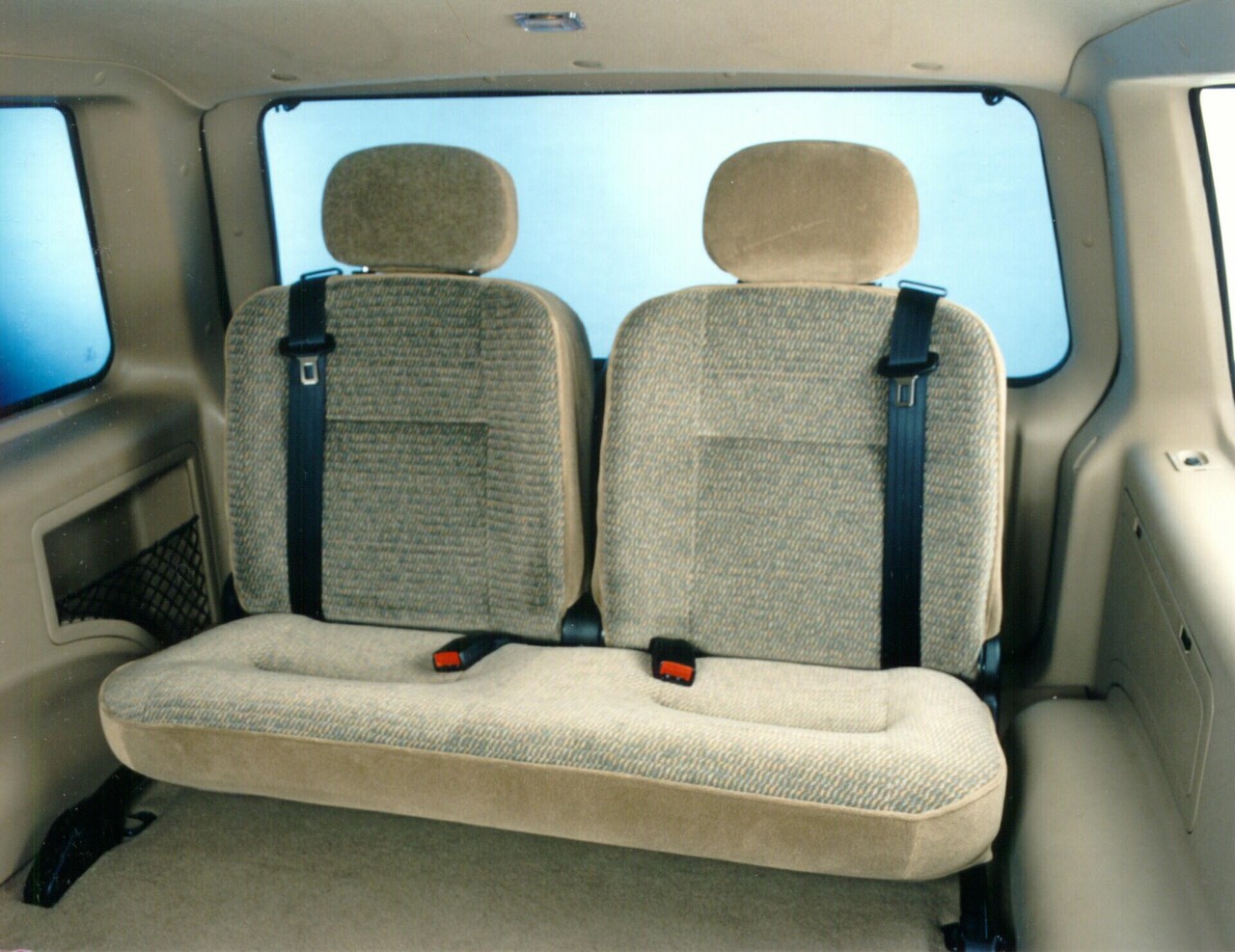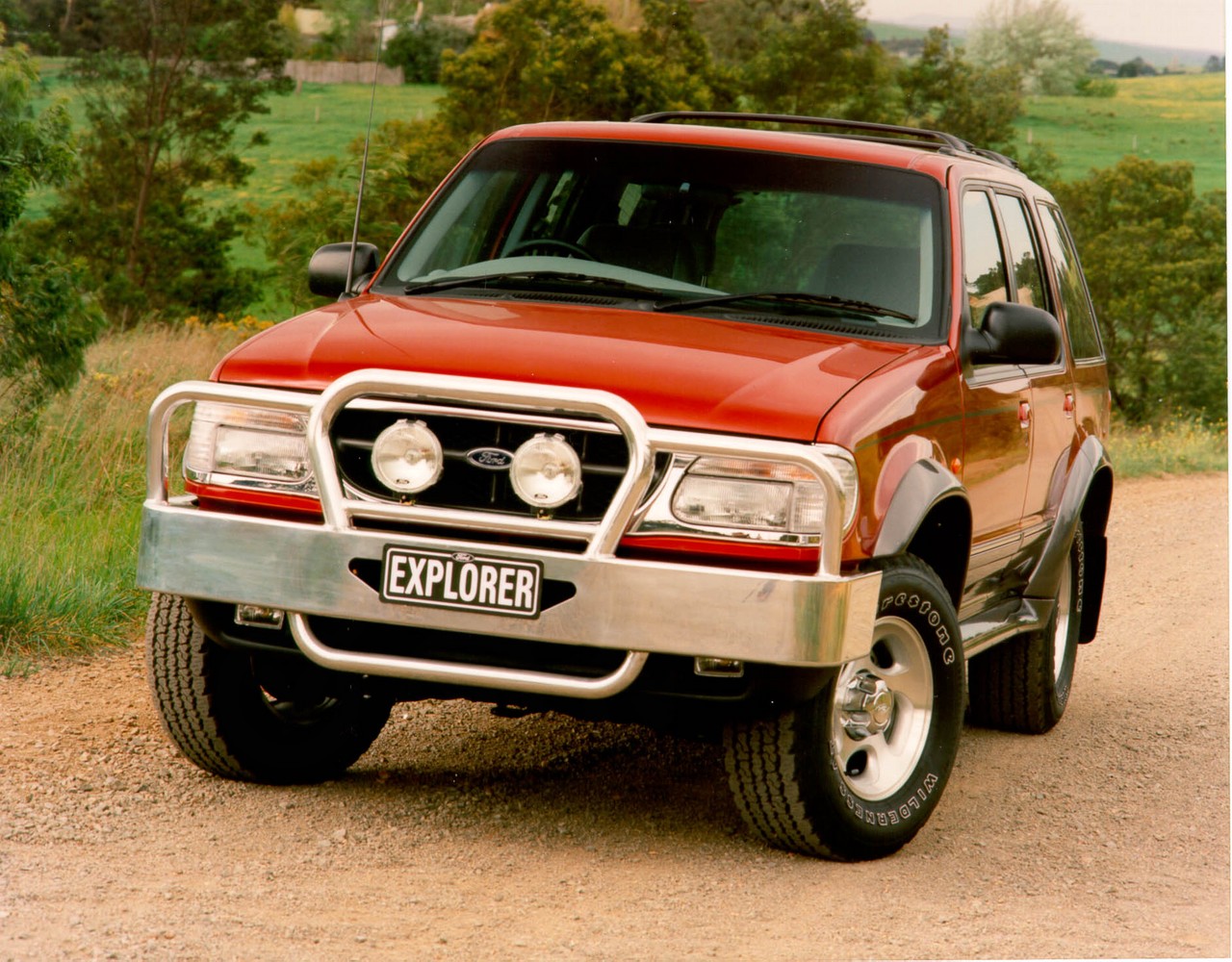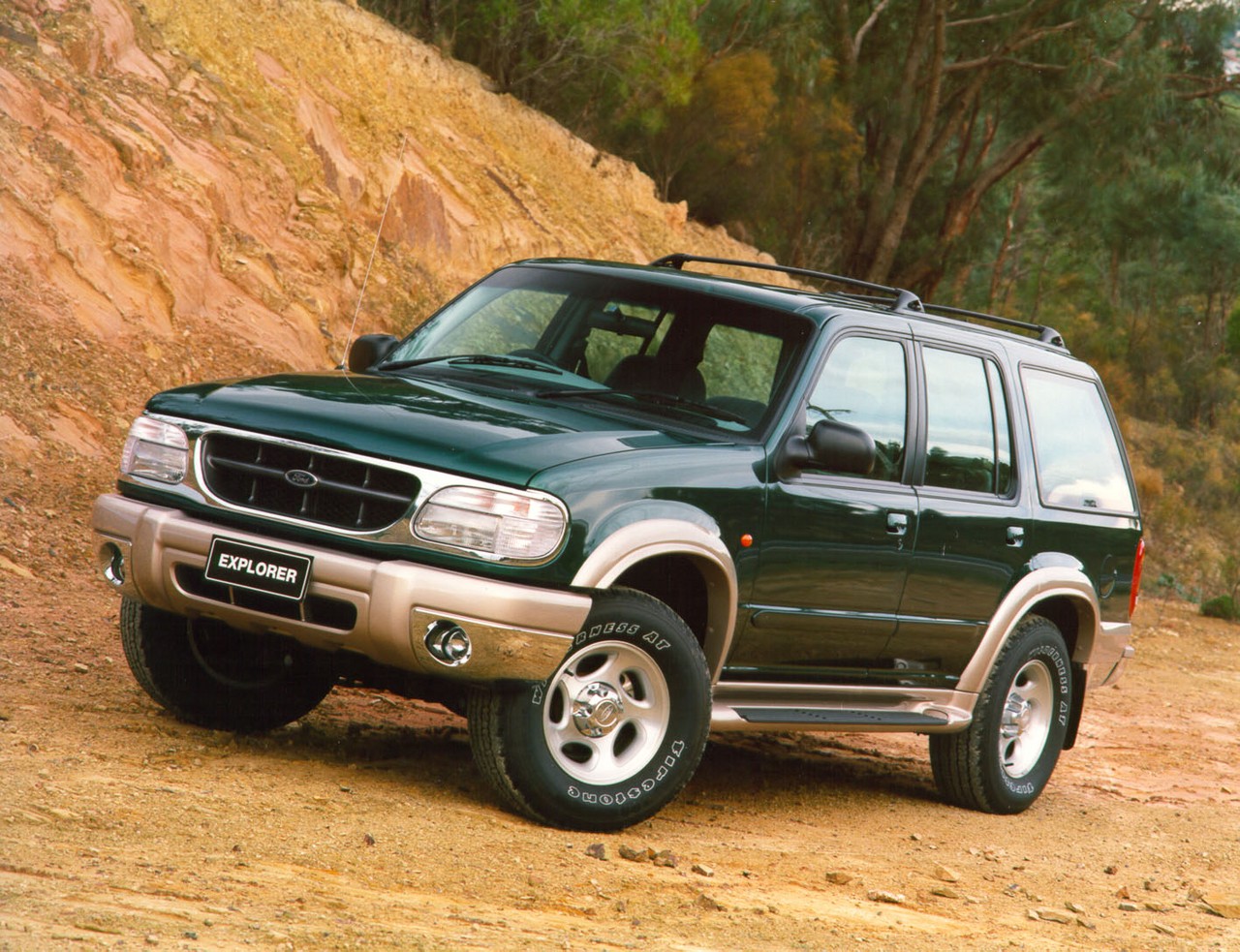
- Responsive 4.0-litre SOHC V6 engine works well with five-speed automatic transmission
- Awkward driving position
- Poor dynamics and basic leaf spring suspension
- Out-dated 4.0-litre OHV engine
Review: Ford UN Explorer (1996-97)
Overview
Released in November 1996, the Ford UN Explorer was a large, four-wheel drive SUV. Manufactured in the United States, the Explorer was available with two different 4.0-litre V6 engines and with either a five-speed manual or five-speed automatic transmission. The Explorer range consisted of XL, XLT and Limited variants.
The 4.0-litre pushrod ‘Cologne’ V6 had overhead valves, hydraulic roller lifters, a compression ratio of 9.0:1 and was solely available with a five-speed M50D-R1 manual transmission. The single overhead camshaft (SOHC) version, however, had a variable length intake manifold and used a jackshaft – in place of a camshaft – to drive a timing chain to each cylinder head. As a result, the engine had three timing chains: one from the crank to the jackshaft, one in front of the engine to drive the cam for the left bank and one on the back of the engine to drive the cam for the right bank. The SOHC engine had a compression ratio of 9.7:1 and was solely available with a five-speed 5R55E automatic transmission.
Based on the North American Ford Ranger pick-up truck, the Explorer had a ladder-frame chassis, was 4805 mm long, 1875 mm wide, 1730 mm tall and had a 2840 mm long wheelbase. Furthermore, the Explorer’s had double wishbone front suspension with torsion bars and a live rear axle with semi-elliptical leaf springs. The Limited variant was also equipped with ‘Adaptive Suspension’ and ‘Automatic Ride Control’, which adjusted ride height and damping rates according to the 4WD mode and general conditions.
| Variants | Engine | Trans. | Peak power | Peak torque |
|---|---|---|---|---|
| XL, XLT |
4.0-litre OHV petrol V6 | 5sp man. | 119 kW at 4200 rpm | 305 Nm at 2800 rpm |
| XL, XLT, Limited |
4.0-litre SOHC petrol V6 | 5sp auto | 153 kW at 5000 rpm | 339 Nm at 3000 rpm |
4WD system
The Explorer was fitted with Ford’s ‘ControlTrac’ four-wheel drive system which included an electromagnetic multi-plate clutch and a limited slip rear differential. The system featured three modes which could be selected via a dash-mounted rotary knob: Auto, 4 High and 4 Low. In ‘Auto’, 90 per cent of the engine’s torque was directed to the rear axle, but the multi-plate clutch would transfer up to 98 per cent of the engine’s torque to the front axle in the event that rear traction was lost.
Safety equipment
Standard safety equipment for the UN Explorer included dual front airbags, ABS and traction control.
Features
Standard features for the entry-level Explorer XL included 15-inch steel wheels, a four speaker sound system with a radio and cassette player and air conditioning.
The Explorer XLT was further equipped 15-inch alloy wheels, cruise control, power adjustable driver’s seat, a leather-wrapped steering wheel, central locking, power mirrors and windows and a tilt adjustable steering wheel.
The range-topping Explorer Limited featured a six-stack CD player, climate control air conditioning, leather seats, a power adjustable driver’s seat with memory settings, remote central locking, power sunroof, roof racks and immobiliser.
Review: Ford UP Explorer (1997-98)
Overview
Released in November 1997, the UP Explorer introduced improved equipment levels, styling and recalibrated power steering for improved response and on-centre feel. Visually, the UP Explorer could be identified by its rounder rear, one-piece step bumper and tailgate latch (replacing a two-way twist T-handle).
Inside, the front seats provided greater lumbar support, an additional console at the base of the gearlever, a ‘self-adjusting’ clutch and a darker tint for the side and rear window panels for greater UV protection and privacy; the XL and XLT also had new seat trims.
| Variants | Engine | Trans. | Peak power | Peak torque |
|---|---|---|---|---|
| XL | 4.0-litre petrol OHV V6 | 5sp man. | 119 kW at 4200 rpm | 305 Nm at 2800 rpm |
| XL, XLT, Limited |
4.0-litre petrol SOHC V6 | 5sp auto | 153 kW at 5000 rpm | 339 Nm at 3000 rpm |
Safety equipment
Compared to its UN predecessor, safety equipment for the UP Explorer was substantially unchanged, though the ABS was revised to improve control on slick surfaces.
4WD and suspension
The ‘ControlTrac’ four-wheel drive system was also updated with Throttle Position Sensing. As such, the system provided a greater proportion of the engine’s torque to the front wheels when accelerating hard on slick surfaces.
Features
Standard features were extended to include cruise control, a leather-wrapped steering wheel, steering wheel tilt adjustment and immobiliser. The Explorer XLT and Limited were further equipped with 16-inch alloy wheels with lower profile (255/70 R16) tyres. Early 1998 XLT variants also featured remote keyless entry.
The UP Explorer could also be optioned with a third row of two seats, suitable for children up to 38kg and 780 mm seated height. The third row seats had integral lap/sash belts, removable headrests and separately folding backrests.
1998 Ford Explorer Quest edition
In October 1998, limited-run Quest editions of the XL and XLT variants were released; the Quest editions featured a polished alloy bull-bar, 100 watt Bosch driving lights (with removable polycarbonate lens protectors) and a six-disc CD stacker.
Review: Ford UQ Explorer (1999)
Overview
Released in June 1999, the UQ Explorer introduced a revised line-up, with the XL and XLT variants only available with manual and automatic transmissions respectively. Other changes included a split-tailgate, more powerful driving lights, re-designed roof racks for greater load capacity and new running boards for the XLT.
| Variants | Engine | Trans. | Peak power | Peak torque |
|---|---|---|---|---|
| XL | 4.0-litre petrol OHV V6 | 5sp man. | 119 kW at 4200 rpm | 305 Nm at 2800 rpm |
| XLT, Limited |
4.0-litre petrol SOHC V6 | 5sp auto | 153 kW at 5000 rpm | 339 Nm at 3000 rpm |
Safety equipment
Standard safety equipment for the Limited variants was improved with front side airbags fitted as standard.
4WD and suspension
The XLT and Limited variants were fitted with self-leveling rear suspension as standard, replacing the ‘Ride Control’ feature which had previously been restricted to the Limited. The self-leveling system monitored the height of the body over the rear suspension and kept the vehicle level by adjusting gas pressure – via a compressor – in the shock absorbers accordingly.
Features
Standard features for UQ Explorer were extended to include 16-inch wheels with heavy duty tyres (previously 15-inch wheels for the XL) and dual sunvisors with covered and illuminated vanity mirrors. The XLT gained a retractable cargo blind, while the Limited was further equipped with a power adjustable front passenger seat.
Review: Ford US Explorer (2000-01)
Overview
Released in January 2000, the US was a minor update for the Explorer.
| Variants | Engine | Trans. | Peak power | Peak torque |
|---|---|---|---|---|
| XL | 4.0-litre petrol OHV V6 | 5sp man. | 119 kW at 4200 rpm | 305 Nm at 2800 rpm |
| XLT, Limited |
4.0-litre petrol SOHC V6 | 5sp auto | 153 kW at 5000 rpm | 339 Nm at 3000 rpm |
Safety equipment and features
Although safety equipment were unchanged, the security system for Explorer XLT and Limited variants was upgraded.
Related links

